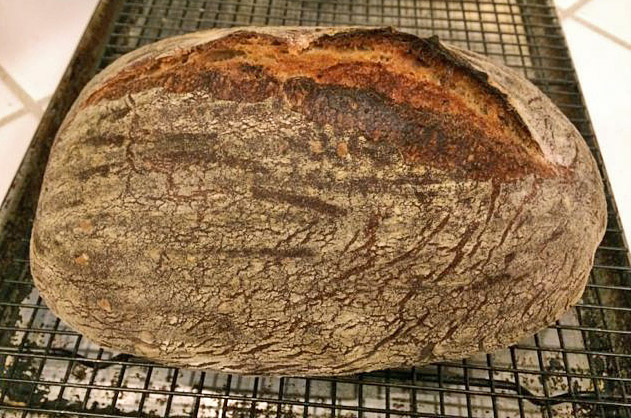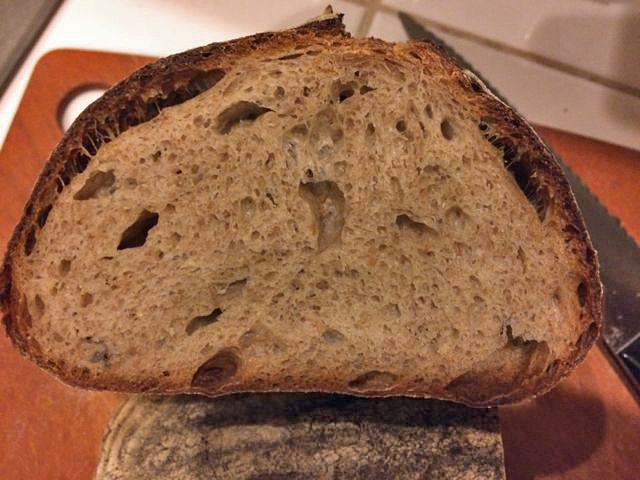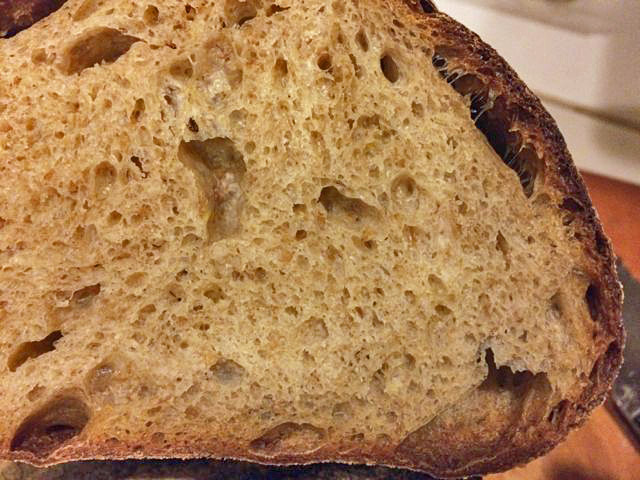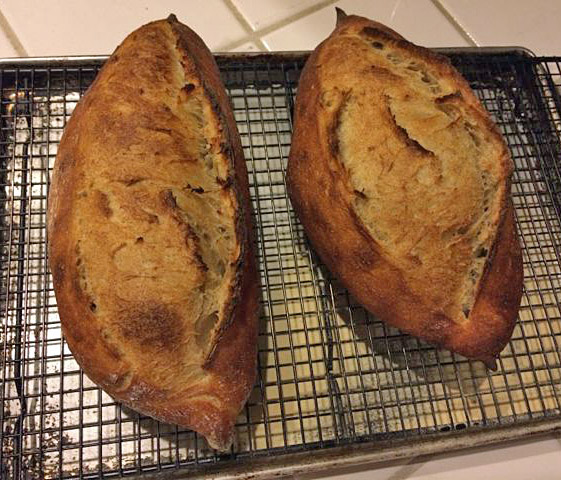Pain au Levain from Della Fattoria Bread, by Kathleen Weber
November 10, 2015
David Snyder
Introduction
My brother, Glenn, bought me a surprise present: A copy of Kathleen Weber's bread cookbook. When I called to thank him, he revealed his motive. He thought I'd like it. We Snyder kids do that sort of thing for each other.
I have had the considerable pleasure of sampling Della Fattoria's breads both at the San Francisco Ferry Building Farmer's Market, where they come with breads and pastries on Saturdays, and also at their cafe in Petaluma, California. They make good stuff. But I believe I first heard of that bakery quite a few years before. It was the “Small Artisan Bakery” featured in Maggie Glezer's Artisan Baking, an award winning book published in 2000.

Weber's book was published in 2014, and it is interesting to compare her methods and how they changed in the interval since she was interviewed by Ms. Glezer. Notably, she began using an autoyse step. She reduced the speed and duration of her mechanical mixing. And she added stretch and folds during bulk fermentation. All three of these changes reflect trends in Artisan baking nationally. All would be expected to enhance the flavor of the product.
Since I am on the subject of Weber's methods in general, her other remarkable idiosyncrasy is that she includes her firm levain in her autolyse, withholding only the salt. And one trend she does not follow (unfortunately, in my opinion) is to not use baker's math in presenting for formulas.
Pain au Levain
Weber's Pain au levain dough is the base for several variations, recipes for which are given in the book. These include a “Potato Levain,” a “Walnut Levain,” a “Sausage-Sage Levain” and other equally tempting breads. For a first bake from this book, I selected the Pain au Levain without any of the additions.
Weber uses a firm levain. She gives clear instructions for making it from scratch. Her mature levain is a 50% hydration mix of 90% All Purpose flour and 10% Whole Wheat flour. She feeds her levain with 23% mature starter. My own customary firm starter isn't very different from this, and that is what I used to feed the levain.
Total dough | | |
Ingredient | Wt (gms) | Bakers' % |
Water (80dF) | 606 | 82.5 |
AP flour | 457 | 62.2 |
WW flour | 209 | 28.4 |
Medium Rye meal+ | 68 | 9.3 |
Sea salt | 16 | 2.2 |
Total | 1356 | 184.6 |
+ Weber calls for pumpernickel flour. I have some, but I have some older rye meal that I thought would work well, and it needed using.
Levain | | |
Ingredient | Wt. (gms) | Bakers' % |
Mature firm starter | 15 | 23 |
AP flour | 57 | 90 |
WW flour | 6 | 10 |
Water (80dF) | 31 | 50 |
Total | 109 | 173 |
Disperse the firm starter in the warm water.
Add the flours and mix very well.
Form into a ball and place in a clean, covered container.
Ferment in a warm place until at least doubled in volume. (4-6 hours, for me).
Final dough | |
Ingredient | Wt (gms) |
Levain | 109 |
Water (80dF) | 551 |
AP flour | 408 |
WW flour | 204 |
Medium Rye meal | 68 |
Sea salt | 16 |
Total | 1356 |
Procedures
Place the levain and the water in the bowl of a stand mixer.
With the paddle, run the mixer at low speed for 1 to 2 minutes, until the levain is dissolved.
Add the flours to the mixer bowl and pulse a few times to start mixing (to prevent flour flying everywhere).
Mix at low speed for 1-2 minutes until the dough forms a shaggy mass. Scrape it together.
Cover the bowl and let the flour absorb the water and start gluten development for 20-30 minutes.
Sprinkle the salt over the dough. Put the dough hook on the mixer.
Run the mixer at low speed for 6 minutes, then at Speed 2 for another 2-3 minutes. (This is a very sloppy dough. It will have some gluten development but will not have cleaned the sides of the bowl. Resist adding more flour.)
Transfer the dough to a lightly oiled 8-10 cup bowl. Do a few “stretch and folds in the bowl.” Cover the bowl, and place it in a warm location. (I used a Proofing Box set at 76dF.)
Perform stretch and folds in the bowl every 30 minutes three times (at 30, 60 and 90 minutes).
Let the dough continue to ferment until it has about doubled in volume and is light and airy. (This was an additional 2 hours for me.)
At this point, you can pre-shape the entire dough to make one large loaf or divide it in half to make two loaves. I divided it into two equal pieces.
Pre-shape into a ball or a log. Cover with a damp towel and let rest for 10-20 minutes.
Shape as a boule or bâtard. Place in bannetons or on a couche to proof.
Proof for about 1.5 to 2 hours or until the depression left when you poke a loaf fills very slowly or remains. (I proofed for about 2 hours at 80dF in the proofing box. I think I slightly over-proofed.)
While the loaves are proofing, preheat your oven to 500dF with a baking stone and your steaming apparatus in place. (Weber recommends a 9” cast iron skillet preheated. She then puts a cooling rack with ice cubes on the skillet at the time she loads her oven.)
When they are proofed, transfer the loaves to a peel. Steam the oven. Score the loaves and load them onto the stone. Turn the oven down to 450 or 460.
Bake with steam for 15 minutes, then remove the steam source and continue baking for another 30 minutes (if baking 700g loaves) or 40 minutes (if baking a 1.3kg loaf.). The bread should be well-colored. It should sound hollow when thumped on the bottom. Internal temperature should be at least 205dF.
Remove loaves to a cooling rack. Cool thoroughly before slicing.



The cuts didn't open up as much as I expected, but I think that was due to over-proofing. There was some tunneling under the top crust which suggests the same.
The crust was crunchy at first but softened by the next day. Not surprising in an 82% hydration bread. The crumb was well aerated but with small, regular holes. The flakes of rye bran were quite visible. I'm sure the whole grain flours determined the crumb structure.
The flavor of the bread was very nice. It had the wheaty and nutty flavors of the whole wheat and the earthy flavors of the rye, both very prominent. There was discernible sourdough tang, but it was very mild. The one negative is that it tasted too salty to me. Looking at the baker's math, you can see that, in fact, there is a much higher percentage of salt in this bread (2.2%) than in most.
This is a good sandwich bread. It is good with cheese and with almond butter. When I first tasted it, I had the thought that I could make a meal of it alone.
I like this bread. If you have a recently fed starter, and you get an early start, it could be done for dinner in one day. I expect to be including it in my regular rotation. But I to want to try a number of the other breads in Weber's book also. I will report on them, when I do.
Happy baking!
David
P.S. I made a couple loaves of San Joaquin Sourdough too.
